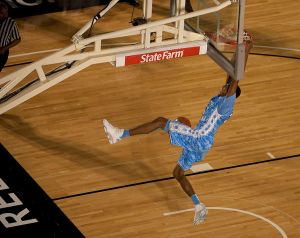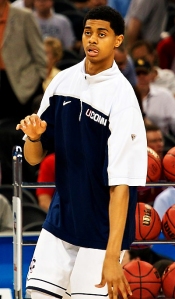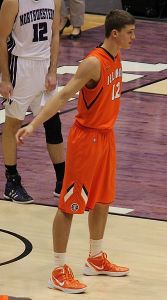With rookie Damian Lillard becoming only the fourth player to be named NBA Rookie of the Year unanimously this past week, we were reminded that having an outstanding rookie year is not the norm. Many players struggle that first year, and who can blame them? This is the biggest transition of their lives, and not just their basketball lives, their whole lives. Not all players who end up having successful careers had dynamite rookie campaigns, and this year’s rookie class has a few players who had quiet first years, but still showed their potential to be NBA difference-makers.
John Henson – Milwaukee Bucks

John Henson came out of North Carolina as the 14th overall pick to the Bucks. The 6’10’’ forward was known for his long wingspan (7’5’’) and narrow frame (220 lbs). He was known to be an athletic shot-blocker and finisher, but many questioned his ability to bang in the post with larger NBA forwards. Henson finished his rookie campaign averaging 6 PPG, 4.7 RPG, and a 48% FG% in only 13.1 minutes per game. These numbers, along with the amount of minutes played, show that Henson only had a small impact his rookie year, but he was one of the most efficient rebounders in the league.
Despite his low minutes, Henson was able to secure the second best rookie, and ninth-best league-wide, rebounding rate at 19.3% of missed shots rebounded. His extrapolated numbers also show what increased playing time could mean for such an efficient player, as he averaged 16.5 points, 12.9 rebounds, and 1.8 blocks per 36 min. While these extrapolated numbers are not always accurate, the last five games of the year saw Henson playing close to the 36 min (33.89 MPG) for the first time consistently. Over this span, the lanky forward averaged 15 PPG, 15 RPG, 2.8 BPG, and a 48% rate from the field. John Henson projects to be a solid NBA player due to his efficiency with his rare chances and solid rebounding game. These flashes, along with increased offensive understanding and strength training, would mean the beginning of a long and productive NBA career.
Jeremy Lamb – Oklahoma City Thunder

This UConn guard was brought to the Thunder as part of the James Harden trade after being drafted 12th overall to the Houston Rockets. Lamb is a smooth-shooting, long, and athletic two guard with the wingspan of a post player (6’11’’). Lamb’s most valuable asset may be his versatility. With better ballhandlers on the court, he can be a deadly spot-up shooter who stretches the D for players like Westbrook and Durant, as well as a ball handler/P&R ball handler when playing with less ball-dominant players. This is because Lamb appears comfortable shooting from the dribble or off of a pass, making him valuable to a team like the Thunder who would seek to use many different looks depending on the personnel on the court. The main rookie problem for Lamb was just getting minutes; he only averaged 6.4 per game and did a stint in the NBADL.
The D-League is hardly NBA competition, but when a guy excels there, at least he is doing what is expected, which is what Lamb did. He averaged 21 PPG, 5.3 RPG, 3 APG, and shot 49% from the field in the D-League, nearly equaling his college numbers as would be expected. What Lamb can do at an NBA level already is shoot. This guy may have my favorite release I’ve studied; it just allows him so many options off a pass. He always bring the ball into a triple-threat position, even if he intends to shoot, because it makes the defender respect his drive. He can get away with this even better than most players, as the quick release of his shot ensures that he can still get the shot off after feigning isolation. This variable in his game must make a defender react, and Lamb is too good with either option for a defender to cheat. Lamb, like Henson, will need to add strength to better handle the NBA, but he benefits from above average athleticism and length. What he began to work on this year, and will need to improve upon to shine, is his role as a facilitator. If he can make teams respect his passing ability, defenders will have to respect three options with the ball in this hand, making his versatility even more valuable.
Meyers Leonard – Portland Trailblazers

Did anyone else know that Meyers Leonard had stretch big potential before the year began? I sure did not predict the 7’1’’ athletic freak to show such shooting touch from the field, as he made 40% of his jump shots this season (up from 26% in his final college season). Coming into the draft, it was thought that Leonard was what he appeared: a raw, super-athletic, huge, big-man prospect in the mold of hulking centers of old. But Leonard showed glimpses recently that he can hit jumpers and spread the floor, as well as the ability to use a go-to left-handed jump hook in the post. An 80.9% clip from the free throw line points to an improved confidence in his jumper that has carried over to the deep corner jumper.
He will have to improve his rebounding numbers (3.7 rebounds in 17.5 MPG), as he seemed somewhat disinterested in good positioning and couldn’t use his size and athleticism to compensate. As a shot-blocker, Leonard does an excellent job going straight up and tracking the ball to avoid fouls or easy buckets. Leonard appears to be the kind of player who could do whatever is asked of him on almost any team for the next ten years, as he can play in the deep post or stretch the floor. Centers with this kind of versatility are rare, and the Blazers got themselves a good one.
By James McNeill Jr
Add The Sports Daily to your Google News Feed!